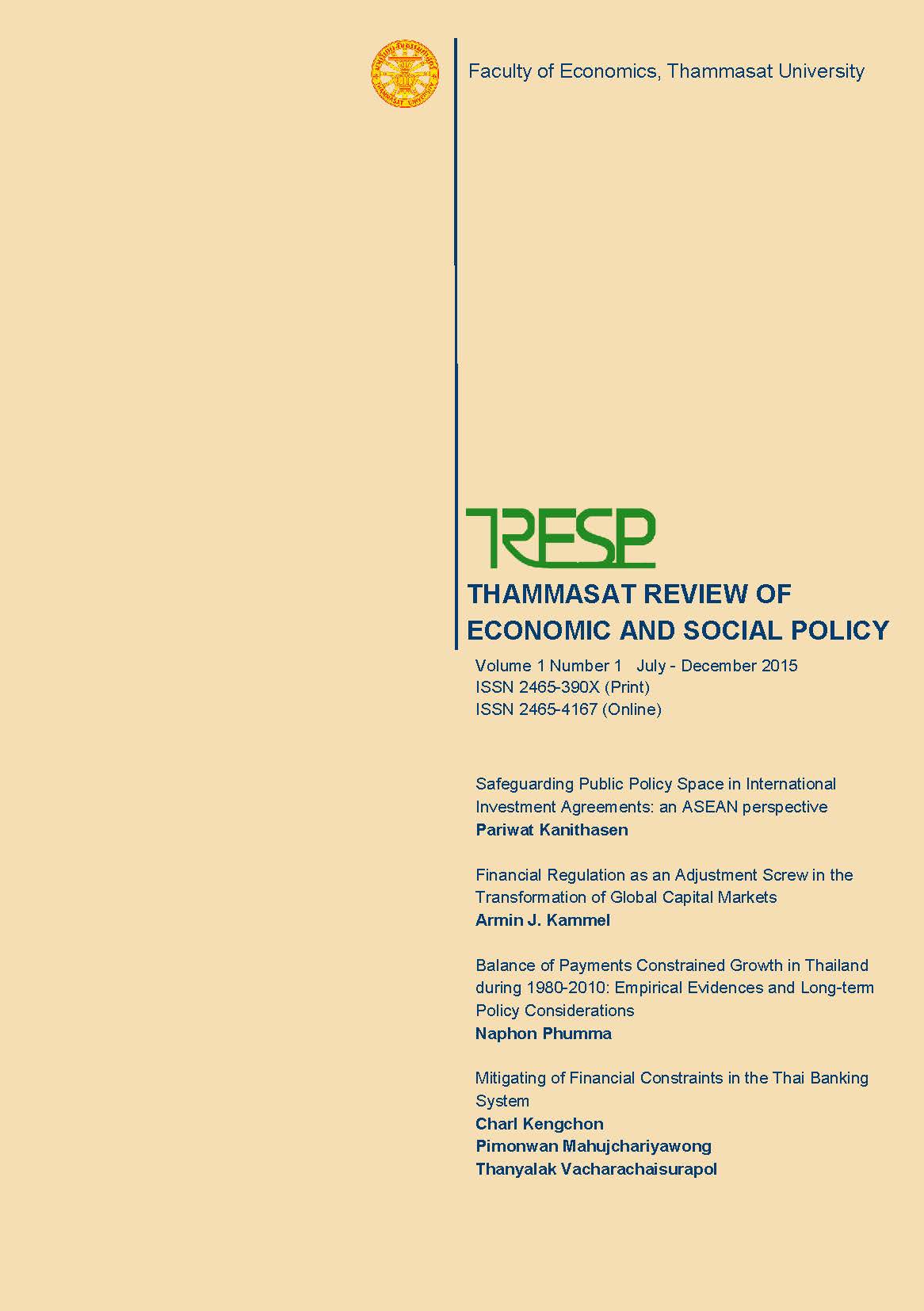Safeguarding Public Policy Space in International Investment Agreements: An ASEAN Perspective
DOI:
https://doi.org/10.14456/tresp.2015.1Keywords:
International Investment agreement, bilateral investment treaty, free trade agreement, investor-state dispute settlement, public policyAbstract
International investment agreements are treaties aimed at attracting foreign investment by providing protection for such investment in the host country. Over 3,200 of such agreements exist globally, including over 300 by ASEAN countries. These agreements also give investors the right to directly challenge their hosts for compensation, in case of breach. They therefore significantly affect the host country’s space in the conduct of public welfare policy, which includes safeguarding the environment, public health or financial stability. This is why there has recently been a wave of critique against the current investment agreement regime. This policy-oriented article highlights current issues relating to international investment agreements. Drawing examples from treaty-making experiences of ASEAN countries, the article shows how these countries attempt to protect their public policy space, most prominently through the inclusion of safeguard clauses into these agreements. However, this does not completely eliminate risks of litigation, and some ASEAN countries have taken more extreme measures by disengaging themselves from such agreements.
References
Anderson, S. (2009). Policy Handcuffs in the Financial Crisis: How U.S. Trade and Investment Policies Limit Government Power to Control Capital Flows. Institute for Policy Studies.
Asia-Pacific Economic Cooperation. (2012). International Investment Agreements Negotiators Handbook: APEC/UNCTAD Modules. IIA Handbook. December, 2012.
Barbee, I. & Lester, S. (2014). Financial Services in the TTIP: Making the Prudential Exception Work. Georgetown Journal of International Law, Vol.45, No. 4.
Berger, A., Busses, M., Nunnenkamp, P. & Roy, M. (2010). More Stringent BITs, Less Ambiguous Effects on FDI? Not A Bit! WTO Staff Working Paper ERSD-2010-10, May 2010.
Bernasconi-Osterwalder, N. & Johnson, L. (Ed.) (2012). International Investment Law and Sustainable Development—Cases from 2000-2010. International Institute for Sustainable Development.
De Meester, B. (2014). Liberalization of Trade in Banking Services—An International and European Perspective. Cambridge University Press.
Eberhardt, P., Olivet, C., Amos, T. & Buxton, N. (2012). Profiting from injustice: How law firms, arbitrators and financiers are fuelling an investment arbitration boom. Corporate Europe Observatory and the Transnational Institute, Brussels/Amsterdam.
Gordon, K. & Pohl, J. (2011). Environmental Concerns in International Investment Agreements: A Survey. OECD.
Mann, H. (2015). ISDS: Who Wins More, Investors or States? In IISD Investment Treaty News, International Institute for Sustainable Development, June 2015
Newcombe, A. (2008). General Exceptions in International Investment Agreements. Draft discussion paper prepared for BIICL Eighth Annual WTO Conference, London: 13-14 May 2008.
Organization for Economic Co-operation and Development. (2008). International Investment Law: Understanding Concepts and Tracking Innovations.
Public Citizen (2009). No Meaningful Safeguards for Prudential Measures in World Trade Organization’s Financial Service Deregulation Agreements. Special Pittsburgh G-20 Report.
Salacuse, J. W. (2010). The Law of Investment Treaties. Oxford University Press.
Spears, S. A. (2010). The Quest for Policy Space in a New Generation of International Investment Agreements. Journal of International Economic Law, Vol. 13 No. 4.
Tieleman, K. (2000). The Failure of the Multilateral Agreement on Investment (MAI) and the Absence of a Global Public Policy Network. UN Vision Project on Global Public Policy Networks.
Traidcraft. (2015). International Investment Agreements Under Scrutiny. Traidcraft Exchange, United Kingdom.
Trakman, L. & Sharma, K. (2014). Why is Indonesia terminating its bilateral investment treaties? East Asia Forum. 20 September 2014.
United Nations Conference on Trade and Development. (2011). Sovereign Debt Restructuring and International Investment Agreements. IIA Issues Note No. 2, July 2011.
United Nations Conference on Trade and Development. (2012). Investment Policy Framework for Sustainable Development.
United Nations Conference on Trade and Development. (2014a). International Finance and Policy Space.
United Nations Conference on Trade and Development. (2014b). The Impact of International Investment Agreements on Foreign Direct Investment: An Overview of Empirical Studies 1998-2014. IIA Issues Note—Working Draft, September 2014.
United Nations Conference on Trade and Development. (2014c). Transformation of the international investment agreement regime. Note by the Secretariat, TD/B/C.II/EM 4/2, 17 December 2014.
United Nations Conference on Trade and Development. (2015). Recent Trends in IIAs and ISDS. IIA Issues Note No. 1, February 2015.



